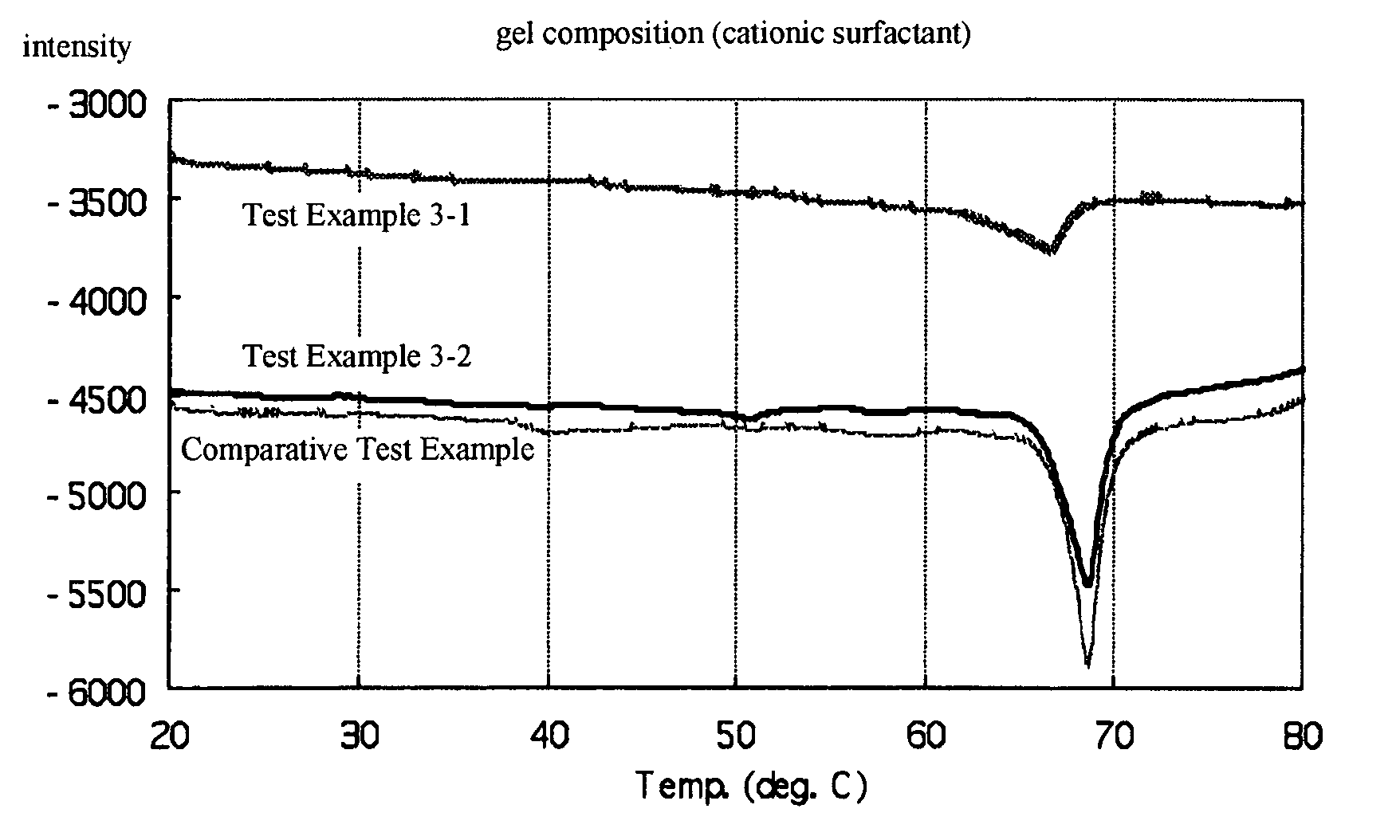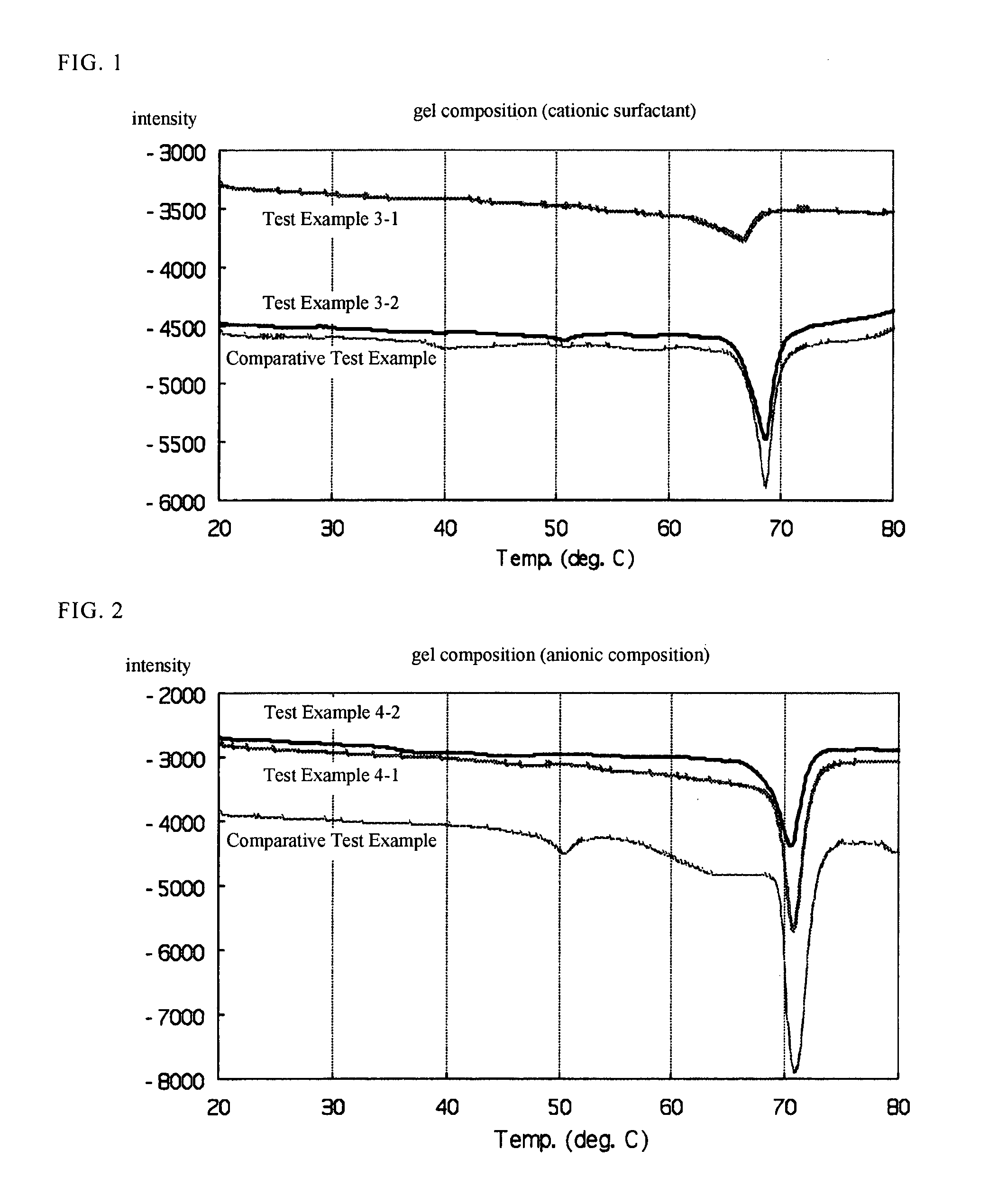Cosmetic and topical skin preparation comprising higher alcohol-modified silicone
a technology of alcohol-modified silicone and cosmetics, which is applied in the direction of hair cosmetics, drug compositions, biocides, etc., can solve the problems of frequent beset, poor absorbability/compatibility with the skin, unsatisfactory compatibility with oily ingredients, etc., and achieves excellent stability, inhibits the crystallization of higher alcohol with elapsed time, and improves the effect of elasticity
- Summary
- Abstract
- Description
- Claims
- Application Information
AI Technical Summary
Benefits of technology
Problems solved by technology
Method used
Image
Examples
synthesis example 1
Higher Alcohol-Modified Silicone No. 1
[0241]89.0 g undecenyl alcohol was introduced into a reactor fitted with a stirrer, thermometer, reflux condenser, and dropping funnel and was heated to 70° C. while stirring under a nitrogen current. 27 mg of a platinum catalyst was added followed by the gradual addition from the dropping funnel of 127.8 g of a methylhydrogentrisiloxane with the average compositional formula MDHM to start the reaction. After the completion of addition, ageing was carried out for 1 hour and the completion of the reaction was confirmed by gas chromatography. Under reduced pressure, the unreacted siloxane was removed at 70° C. followed by heating to 150° C. and removal of the internally converted and excess undecenyl alcohol to obtain higher alcohol-modified silicone No. 1. The yield was 168.1 g or 82%. The product had a refractive index of 1.431 and a kinematic viscosity of 38.0 mm2 / s and was a light yellow transparent liquid.
synthesis example 2
Higher Alcohol-Modified Silicone No. 2
[0242]50.0 g undecenyl alcohol was introduced into a reactor fitted with a stirrer, thermometer, reflux condenser, and dropping funnel and was heated to 70° C. while stirring under a nitrogen current. 60 mg of a platinum catalyst was added followed by the gradual addition from the dropping funnel of 192.6 g of a methylhydrogenpolysiloxane with the average compositional formula MHD14MH (0.122 SiH %) to start the reaction. After the completion of addition, ageing was carried out for 4 hours. After confirmation of the development of the reaction by confirmation of the extinction of the Si—H from the IR spectrum, heating was carried out to 150° C. under reduced pressure and the internally converted and excess undecenyl alcohol was removed to obtain higher alcohol-modified silicone No. 2. The yield was 230.4 g or 73%. The product had a refractive index of 1.419 and a kinematic viscosity of 107.5 mm2 / s and was a light brown transparent liquid.
synthesis example 3
Higher Alcohol-Modified Silicone No. 3
[0243]55.0 g undecenyl alcohol was introduced into a reactor fitted with a stirrer, thermometer, reflux condenser, and dropping funnel and was heated to 70° C. while stirring under a nitrogen current. 124 mg of a platinum catalyst was added followed by the gradual addition from the dropping funnel of 199.2 g of a methylhydrogenpolysiloxane with the average compositional formula MD19DH2M (0.118 SiH %) to start the reaction. After the completion of addition, ageing was carried out for 5 hours. After confirmation of the development of the reaction by confirmation of the extinction of the silicon-bonded hydrogen atom (indicated by “Si—H” below) from the IR spectrum, heating was carried out to 150° C. under reduced pressure and the internally converted and excess undecenyl alcohol was removed to obtain higher alcohol-modified silicone No. 3. The yield was 207.9 g or 87%. The product had a refractive index of 1.421 and a kinematic viscosity of 123.7 ...
PUM
| Property | Measurement | Unit |
|---|---|---|
| melting point | aaaaa | aaaaa |
| melting point | aaaaa | aaaaa |
| melting point | aaaaa | aaaaa |
Abstract
Description
Claims
Application Information
 Login to View More
Login to View More - R&D
- Intellectual Property
- Life Sciences
- Materials
- Tech Scout
- Unparalleled Data Quality
- Higher Quality Content
- 60% Fewer Hallucinations
Browse by: Latest US Patents, China's latest patents, Technical Efficacy Thesaurus, Application Domain, Technology Topic, Popular Technical Reports.
© 2025 PatSnap. All rights reserved.Legal|Privacy policy|Modern Slavery Act Transparency Statement|Sitemap|About US| Contact US: help@patsnap.com



